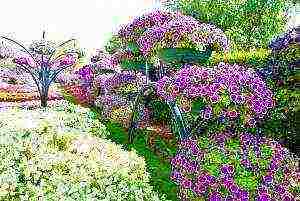Content
Bell peppers can be successfully grown in the Urals, and not only in a greenhouse, but also in the open field. But for this you need to choose the right variety. Which one - find out from our article.
When growing sweet peppers in the Urals, it is better to use the seedling method and plant the plants in a greenhouse. But many experienced gardeners grow early maturing varieties in the open field and reap a good harvest. How do they do it?
When choosing a variety, it is necessary to take into account not only the ripening period, but also winter hardiness, and the light zone. Many varieties listed in the register are only theoretically suitable for growing in the unstable climate of the Urals, but in fact, during the short and cold summer, the pepper simply does not have time to ripen.
We have prepared for you a list of sweet pepper varieties that are best suited for growing in the Urals.
Bogatyr
The pepper of this mid-season variety grows well in difficult weather conditions in the Urals: it is undemanding to light and tolerates low temperatures. The hero is famous not only for his unpretentiousness. Its sweet and juicy red fruits resemble a cone in shape and can reach a length of 18 cm. Plus, they have an excellent presentation and are not damaged during transportation, so they can be grown for sale.
| Appointment | Growing | Ripening period (days) | Fruit weight (g) | Productivity (kg / sq.m) |
| 115-131 | 75-100 | 2,2-4 | ||
Winnie the Pooh
The bush of this early ripening variety is very compact: it grows only up to 30 cm in height, and the weight of the fruit does not exceed 50 g. But this fact does not in any way affect the taste of the pepper - they are excellent. The fruits of Winnie the Pooh are bright red, cone-shaped.
| Appointment | Growing | Ripening period (days) | Fruit weight (g) | Productivity (kg / sq.m) |
| 107-110 | 48-50 | 1,6-1,8 | ||
Yellow bull, Red bull
These mid-early varieties differ only in the color of the fruit. As you might guess, the first variety has yellow fruits, the second - red. They are very large, similar in shape to a prism with a ribbed surface.
The bushes on which the pepper ripens are quite tall and strong. The main value of both varieties is a very high yield and a good presentation of the fruit.
| Appointment | Growing | Ripening period (days) | Fruit weight (g) | Productivity (kg / sq.m) |
| 95-108 | 167-200 | 14-20,5 | ||
Merchant
This pepper is very aromatic and juicy. However, it has many other advantages: the variety is early maturing, with sweet large red fruits, resembling a cylinder in shape. The height of the bush is up to 85 cm. Pepper continues to ripen on it until autumn. In addition, the Kupets tolerates large temperature drops well, which is important for the Ural region.
| Appointment | Growing | Ripening period (days) | Fruit weight (g) | Productivity (kg / sq.m) |
| 109-111 | 62-130 | 1,3-2,2 | ||
Montero
On a tall bush (about 120 cm) of the Montero variety, there are large scarlet fruits, the mass of which, when grown in a greenhouse or under a film, can reach 250 g. And this is not the limit!
In 2002, a record weight was recorded for the Montero sweet pepper. It was 940 g.
| Appointment | Growing | Ripening period (days) | Fruit weight (g) | Productivity (kg / sq.m) |
| 90-100 | 240-260 | 7-14 | ||
Pioneer
According to amateur gardeners cultivating sweet peppers in the Urals, Pioneer is the only variety that is ideal for growing outdoors in the harsh conditions of this region.
The pepper bush grows up to 70 cm, on it are medium-sized cone-shaped fruits, which, as they ripen, acquire a deep red color. The only drawback of this variety is its low yield. But for its cultivation, you do not need to build any special devices.
| Appointment | Growing | Ripening period (days) | Fruit weight (g) | Productivity (kg / sq.m) |
| 116-135 | 55 | 0,8 | ||
Useful tips for caring for sweet peppers in the Urals
- Pepper loves warmth and good lighting, so it is better for novice gardeners to grow it in a greenhouse or in warm beds. In the Urals, summer is late and short, and even unpretentious varieties of pepper may not have time to ripen.
- When grown in seedlings, seeds are sown in February-March. Flowers appear on the plant in May. In the southern regions, they are usually cut off, but in the Urals this is not worth doing: there is a risk that the fruits will not have time to ripen. Better to take a cotton swab or a thin brush and dust the flowers. So the fruits will set faster.
- It is advisable to plant seedlings or seeds in open ground when the average daytime temperature of at least 13-15 ° C is established outside. And if there is a threat of frost, the beds must be covered with spunbond.
- Sweet peppers respond well to feeding with organic fertilizers, therefore, before planting, compost or humus must be added to each hole at the rate of 3-4 kg / m2.
- To increase the endurance of the peppers and help them "survive" in the difficult weather conditions of the Urals, during the growing season it is necessary to spray the plants with a mixture of Epin and Zircon every 2 weeks (1 ampoule of each substance is diluted in 10 liters of water).
- In order to have time to collect the maximum yield for a short Ural summer, the fruits of the pepper must be removed a little unripe. So you will give the opportunity to sooner grow into the growth of recently set small peppers.
Choose the right varieties and you can harvest a good sweet pepper crop even in a cold region. Once you have tasted the fruits of your own hands, you no longer want to buy vegetables in the store. After all, the pepper from your own site is much tastier!
The peculiarity of the Urals climate is that the weather is changeable, cold winds often blow, summer is short with an average temperature of 20-22 ° С. Such conditions do not look particularly attractive for growing a heat-loving crop. But a large list of hybrids and varieties allows you to choose peppers for the Urals, which will grow and bear fruit perfectly. And simple agronomic techniques will help to achieve good results in growing peppers, even in a cool summer.

The best varieties of salad peppers for the Urals
How to choose
When choosing varieties of sweet peppers for the Urals, you need to pay attention to the description of the culture in order to find out what features are characteristic of it. The following types are best suited:
- Determinant (undersized) - plants will not expend extra energy to build up a large amount of green mass, and in case of cold snaps, such a variety can be easily covered.
- Early ripe (100-120 days) - in a short summer period they will have time to set and ripen.
- Resistant to changes in weather conditions - will be able to cope with short-term weather deterioration and temperature changes.
In the Urals, it is practiced to grow peppers both in greenhouses and in the open field. And a properly selected variety plays an important role in the successful cultivation of such a southern crop in climatic conditions uncharacteristic for it.
Through the efforts of breeders, a large number of varieties have been bred that will satisfy these requirements and will delight with the harvest even in the changeable weather of the Urals.
The best varieties for the Urals
Among the varieties that are suitable for growing in the Urals, it is worth highlighting the best. Pepper varieties for the Urals can be selected depending on the planned planting site and ripening time.
Growing in greenhouses
Peppers in the Urals are often grown indoors. Greenhouses:
- heated;
- glass;
- polycarbonate;
- film.
They are all great for growing sweet bell peppers. Growing in a greenhouse makes it somewhat easier to care for plants in cooler climates.

Peppers are more commonly grown in greenhouses.
Belladonna F1
Seminis Dutch hybrid. Bushes grow compact, 50-60 cm high with well-developed skeletal branches. This variety is ultra-early, the fruits begin to ripen after 60-70 days from the moment the seedlings are planted in the greenhouse. They are distinguished by high and stable productivity. On the bush, 9-12 fruits ripen, weighing 180-210 g. The fruits have a cuboid four-chamber shape, at the time of technical ripening they acquire a creamy yellow color, when fully ripe they have a beautiful uniform yellow color. The thickness of the pulp is 5-9 mm, the length of the fruit is 8-10 cm, the width is 7-8 cm. It has a universal purpose. They appreciate it for its good taste and excellent presentation. Resistant to diseases such as tobacco mosaic.
Giganto Rossa F1
Large-fruited, mid-early hybrid variety (3 months after planting the seeds, the first crop can be harvested). The bush of the plant is predominantly of medium height, develops compactly, does not require formation. Fruits grow weighing more than 250 g, 20-26 cm long, 7-9 mm walls of deep red color at the stage of biological maturity. They have a cubic shape.
It is appreciated both for its large fruits and for its pleasant taste, juicy and dense structure. Rich in vitamin C, and the amount of sugar is about 6%.
Banana dessert
Refers to medium early varieties. Unique long-fruited variety. Fruits grow 30-35 cm long with an average weight of 250 g, even with thick walls up to 1 cm. At the beginning of ripening it has a vanilla-yellow color, at the moment of reaching biological maturity it becomes dark red. The multiple ovary looks like a bunch of bananas. The stage of technical ripeness occurs in 120-130 days. The height of the bush is up to 0.7 m. It has a stable yield in the range of 5-7 kg per 1 sq. M.
The taste of pepper is sweet, the structure of the pulp is homogeneous, juicy. Well suited for fresh salads, cooking and preservation.
Agapovsky
Refers to semi-determinant varieties with an early ripening period. The height of the bush reaches an average of 90 cm. From the moment of sowing seeds for seedlings to the ripening of the first fruits, 110-125 days pass. The fruits are not large, on average they weigh 120 grams, but the variety has a high and most stable yield among peppers with similar characteristics. From 1 sq. M. about 10 kg of crop can be harvested. The fruits are cubic in shape. Wall thickness 6-7 mm. At the moment of full ripening, they acquire a deep red color and a beautiful glossy shine. They have a pleasant taste and juicy homogeneous pulp. It tolerates short-term cold snaps at night. Very simple and undemanding to care for. Has a high resistance to disease.
Apricot Favorite
Determinant type, plants grow compact, well developed up to 50 cm in height. The first harvest of the Apricot Favorite is harvested in 100-105 days. It has a high yield, from one bush you can collect 20-22 fruits weighing 125-150 g. Fruits have a beautiful orange color. The shape is cuboid with division into four chambers. The skin is firm but thin with a smooth surface and a waxy sheen. The wall thickness is on average 6-7 mm. The fruit has a pleasant taste and pronounced aroma.
Cornet
Peppers of this variety are distinguished by a unique chocolate brown color. It will be of interest to connoisseurs of exotic vegetables. Cornet ripens in 105-115 days from the moment of sowing the seeds. It has a high yield, more than 3 kg of peppers ripen on one bush. Large-fruited fruits 200-230 g, wall thickness 6-7 mm. The bush is semi-determinate, slightly branched, there are few leaves on the plant. This is one of the varieties that, even with a bush height of 1-1.5 m, ripen perfectly in the Urals.
For 1 sq. m you can plant up to 5 plants.
For outdoor cultivation
Despite the capricious weather in the Urals, pepper, with proper agricultural technology and growing by seedlings, grows well and bears fruit in the open field.
Gingerbread man
A sweet bell pepper variety that has proven itself not only for cultivation in the Urals, but also in many other regions. Early maturing type (110-120 days), with a very compact and undersized bush 40-50 cm.It has round fleshy fruits, weighing 90-130 g, thick walls 1 cm or more, at the time of technical ripeness it is green, after 2 weeks it becomes red color. The seeds are very small in a shallow seed chamber. Differs in high yield, per 1 sq. M. ripens 6-7 kg, which is a very high figure for peppers grown in the open field. It has a universal purpose, suitable for fresh consumption and processing. Gingerbread man is not picky about care and growing conditions. Resistant to temperature drop. Rarely sick with tobacco mosaic, gray rot, top rot.
Eroshka

Bushes grow quite often
Belong to the early maturing type. The bushes are very compact, their height reaches only 30-45 cm. They can be planted tightly, about 10 bushes can grow on 1 meter, using the belt planting method (between plants 15-20 cm). On a small area, it allows you to get a high yield. 12-16 fruits ripen on one bush. Which in the stage of absolute maturity have a red color with an orange tint. Fruits are cuboid, weighing 180-200 g, 10-12 cm long and 7 cm wide. Wall thickness 6 mm. Ripening is simultaneous, amicable.
Resistant to some diseases inherent in peppers:
- gray rot;
- verticilliosis;
- top rot;
- tobacco mosaic.
You can use the variety as a sealant for tall varieties of peppers, tomatoes, eggplants. Eroshki bushes are planted between indeterminate plants.
Funtik
A high-quality and stress-resistant early variety, from sowing to the ripening of the first fruits, it takes 105-115 days. Semi-determinant bush, well developed, height up to 70 cm. Planting density 5 bushes per 1 sq. M. One bush grows 15-18 fruits weighing 120-180 g. They have a conical shape, evenly tapering towards the tip. Fruit sizes 14x8, wall thickness 6-8 mm. The ripe fruit is sweet, red in color. The peppers ripen together. They are distinguished by good taste, universal purpose.
Czardas
A variety that has proven itself well in unstable weather conditions. Belong to early varieties, ripens to the stage of technical maturity in 95-110 days, and to biological 110-125 days. Has high yield rates. On small bushes (up to 70 cm high) 15-18 fruits are tied. From sq. m. more than 10 kg of crops are harvested. Suitable for dense planting, 5-8 bushes per 1 sq. M.
The fruits have a special decorative effect and good presentation. A sweet fruit grows, weighing 180-220 g, with a size of 16x8 cm in a conical shape with a sharp end. Wall thickness 5-6 mm. The color of ripe fruits is from light orange to red-orange. Suitable for fresh consumption, home and industrial processing.
Secrets of growing pepper in the Urals
The key to a positive experience in pepper cultivation will be:
- correct sowing time of seeds;
- compliance with the timing of disembarkation of seedlings;
- warming the garden;
- temperature control.
For successful cultivation of pepper in the Urals, it is better to use the seedling method.
Seeds for seedlings in this region are sown in mid-March for the greenhouse, and in early April for open ground. Do not rush to sow seeds ahead of time, since sweet pepper seedlings in the Urals can be planted only at the moment when night temperatures stabilize and reach 14-15 C, and the soil warms up enough. This is approximately mid-May for greenhouses and not earlier than the 20th of May for open ground. Seedlings at the time of disembarkation should be 45-60 days old.
Warming up the beds will be important when planting seedlings, this can be done using:
- manure;
- natural stone;
- plastic water bottles.
In order for the bushes to grow better and not suffer from nighttime drops in temperature, the bed is warmed up, for this it is practiced to lay manure in the aisles before planting seedlings. Remove 20-30 cm of soil, spread cow or horse manure and cover with removed soil. This method is used for greenhouses and for open ground. Consumption 3 kg per 1 sq. M. And also stones or bottles filled with water are laid out on the garden bed, which in the daytime will be heated by the sun, and at night they will give heat to the soil.
Often, even in the summer period, a decrease in temperature in the daytime below 18-20 is observed, low temperatures cause a delay in the growth of sweet pepper and postpone the ripening of fruits. In such a situation, the best option would be to cover the bushes in open beds with agrofibre and additionally insulate the greenhouse with a film or non-woven material.
Pepper varieties for the Urals. How to make the right choice.
Review of varieties of large-fruited peppers. The best varieties of thick-walled peppers 2017.
Best Sweet Peppers
Conclusion
Modern science in the field of selection and agronomy, as well as the proper care of gardeners, make it possible to grow pepper crops even in such a risky region for agriculture as the Urals. There are a large number of quality varieties on the seed market. You can plant several different varieties in one season - this will help you finally decide on your favorites.
Similar articles

Reviews and comments
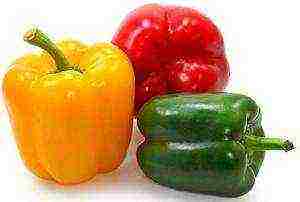 Pepper is an annual crop belonging to the Solanaceae family. There are more than two thousand species of this plant. Its fruits contain minerals vital for humans, carotene, and it is also a storehouse of vitamin C. The use of pepper helps to normalize blood pressure, strengthens the immune system, improves the functioning of the gastrointestinal tract, and gives the skin a healthy color. Also, pepper pleases with a variety of tastes: bitter, sweet, sour, sweet and sour, etc.
Pepper is an annual crop belonging to the Solanaceae family. There are more than two thousand species of this plant. Its fruits contain minerals vital for humans, carotene, and it is also a storehouse of vitamin C. The use of pepper helps to normalize blood pressure, strengthens the immune system, improves the functioning of the gastrointestinal tract, and gives the skin a healthy color. Also, pepper pleases with a variety of tastes: bitter, sweet, sour, sweet and sour, etc.
A distinctive feature of this vegetable is disease resistance, which allows you to grow peppers in any soil. Previously, this thermophilic plant was planted only in the southern regions. Today, using covering means, the best varieties of pepper are successfully grown in Siberia and the Urals. To get a good harvest, you need to choose the right variety that will be "comfortable" in this area. Early and mid-season peppers are suitable for planting.
What are the best peppers for Siberia?
For a fairly cold Siberian region, early ripening varieties of pepper have been bred. This useful product has been successfully cultivated here for several decades. Adhering to the rules of care, planting crops and performing all agrotechnical measures, gardeners harvest crops that do not disappoint them. Before planting pepper seeds for Siberia, you must purchase a package that indicates that the variety is for this region.
The following early varieties are most suitable for harsh climates:
Siberia has a harsh continental climate with short summers. Therefore, vegetable experimental stations develop varieties adapted to the local climate. They are mid-season, ripen in 95-120 days with high yields.
Breeders offer the best hybrid varieties of peppers for Siberia:
- The firstborn of Siberia is a mid-season sweet pepper, bred at the West Siberian Vegetable Experimental Station. The height of the bush is 40-45 centimeters, the length of the fruit is 9 centimeters, the wall thickness is 8-10 millimeters, the average weight of the fruit is 49-53 grams. Red or yellow pyramidal pepper with sweet juicy pulp. The crop can be harvested in 100-110 days at the rate of 3.5-4 kg / m2.
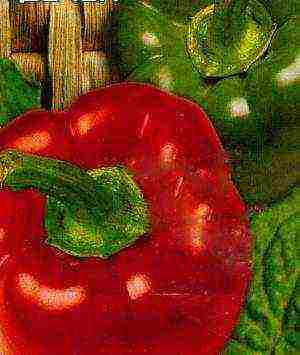 For cultivation in the closed ground in the Central Siberian Botanical Garden, the early-maturing variety Novosibirsk was selected. Usually the seeds of peppers in Siberia are sown in February. After a couple of months, the sprouts are transplanted into greenhouse soil. The fruits ripen in 95-100 days, the yield is 3.5-4 kg / m2. On a bush, up to 100 centimeters high, there are bright red single fruits weighing 50-58 grams.The thickness of the pulp of such peppers is from 4 to 6 millimeters.
For cultivation in the closed ground in the Central Siberian Botanical Garden, the early-maturing variety Novosibirsk was selected. Usually the seeds of peppers in Siberia are sown in February. After a couple of months, the sprouts are transplanted into greenhouse soil. The fruits ripen in 95-100 days, the yield is 3.5-4 kg / m2. On a bush, up to 100 centimeters high, there are bright red single fruits weighing 50-58 grams.The thickness of the pulp of such peppers is from 4 to 6 millimeters.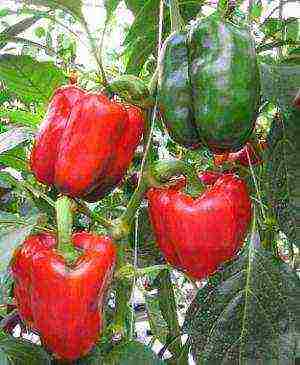 A very promising variety of mid-season pepper Sibiryak, belonging to the variety of sweet peppers for Siberia. It is a short bush (60 centimeters on average) with cuboid fruits. Even under unfavorable conditions, fruits are tied and 6-7 kilograms per square meter can be harvested. Fruits are red in color, fleshy, large, 100-150 grams each, tolerate transportation well. From germination of sprouts to technical ripeness, 115-118 days pass. The pepper is recommended for cultivation in heated and unheated, as well as in winter greenhouses. The variety is included in the State Register of the Russian Federation.
A very promising variety of mid-season pepper Sibiryak, belonging to the variety of sweet peppers for Siberia. It is a short bush (60 centimeters on average) with cuboid fruits. Even under unfavorable conditions, fruits are tied and 6-7 kilograms per square meter can be harvested. Fruits are red in color, fleshy, large, 100-150 grams each, tolerate transportation well. From germination of sprouts to technical ripeness, 115-118 days pass. The pepper is recommended for cultivation in heated and unheated, as well as in winter greenhouses. The variety is included in the State Register of the Russian Federation.
What are the best varieties of peppers for the Urals?
In the Urals, it is customary to grow pepper in the open field, but under a film shelter or in an unheated greenhouse. Seedlings are planted at the end of May: in the greenhouse - 20-25, in open ground - May 25-30. Despite the capricious and harsh weather, vegetable growers of the mountainous region are pleased with numerous varieties of peppers for the Urals every year. Early varieties always have time to "give back" the harvest in the summer, as they ripen, on average, in three months.
Early maturing varieties include:
- Montero. This sweet pepper is 100-120 centimeters high with red prism-shaped fruits. Its fruits reach a weight of 240-260 grams, the record weight of the fruit is 940 grams. The wall thickness is about 7 millimeters. The variety is distinguished by excellent taste and unpretentiousness. It can be grown in all types of greenhouses. Collect 7-16 kilograms of pepper per square meter.
- Merchant. It takes a little more than two months for the fruits to ripen. On the bushes, peppers weighing about 70 grams appear with fleshy walls - 5-7 millimeters. The yield of the Kupets variety is 2-3 kg / m2. Pepper has a high content of ascorbic acid.
 Pioneer. Bred at the Ukrainian Research Institute of Vegetable and Melon Growing in 1987, it is recommended for cultivation in the Ural lands. An early ripening vegetable takes 116-135 days to ripen. The height of the culture is 70 centimeters, the fruit is a red cone with a sharp top. Pepper weighing 55 grams, wall thickness - 4 millimeters. Although the yield is low - 0.8 kg / m2, but in the open field.
Pioneer. Bred at the Ukrainian Research Institute of Vegetable and Melon Growing in 1987, it is recommended for cultivation in the Ural lands. An early ripening vegetable takes 116-135 days to ripen. The height of the culture is 70 centimeters, the fruit is a red cone with a sharp top. Pepper weighing 55 grams, wall thickness - 4 millimeters. Although the yield is low - 0.8 kg / m2, but in the open field.- Winnie the Pooh is a variety of early ripening pepper. From germination to ripening of fruits 110 days pass. The plant is compact, low - 30 centimeters. By the end of the season, many small red cones appear on it, collected in a bouquet. The fruits ripen almost simultaneously.
Of the mid-season varieties of peppers for the Urals, one can single out:
If, in addition to sweet pepper, bitter is also grown, then another greenhouse is prepared for seedlings, otherwise the pollen will be blown away by the wind, and the sweet pepper will have a bitter taste. You can plant hot peppers in a flower garden, then all summer the flower bed will be full of red fruits. A harvest of hot pepper from just five bushes is enough for a whole year for a family of four.
In addition to the above, the best varieties of pepper for Siberia and the Urals include Triton, Kudesnik, Edino, Yantar, Buratino, Aries, Zorka, Alenushka, Anlita, Bagheera, Leader of the Redskins, Swallow and others.
The best varieties of pepper - video
Welcome all!
Today I want to tell you about the varieties of pepper for the Urals. Bell peppers grow well in our country, especially in greenhouses and film shelters, but you can also get a good harvest in the open field. You just need to choose the right type of pepper. It is better to grow through seedlings, but, like early varieties of tomatoes, early varieties of peppers can also be sown directly into the ground.
The early varieties will definitely have time to give you their harvest, and in the greenhouse it is also good to grow mid-season varieties of peppers - they will bear fruit until the cold weather. So, in more detail about
Pepper varieties for the Urals
Let's start with the early varieties of sweet peppers
- Montero - early ripening variety, about 100 days pass from the first shoots to the first fruits. Montero is a tall plant up to 120 cm. Large-fruited - bright scarlet fruits gain an average weight of up to 200 grams, but can be much larger (it all depends on the care).Elongated prismatic shape, wall thickness about 7 mm, very tasty variety. It is advisable to grow in a greenhouse.
Montero pepper variety
- One - an early ripe popular variety that adapts to any growing conditions. It grows in a wide variety of climates. Can be grown both indoors and outdoors. The bush is up to 75 centimeters high. Fruits in the form of a cube (about 10 by 12 cm), deep red color in biological ripeness, wall thickness of about 1 cm. The variety is very productive, bears fruit stably even in bad weather conditions. Delicious fresh, suitable for all types of canning. This variety is suitable for non-seedling cultivation.
-
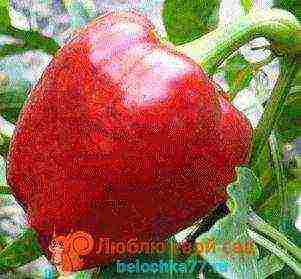 Pepper variety Edino
Pepper variety Edino - Winnie the Pooh - early ripening variety. From full shoots to fruits, it takes up to 110 days. The plant is the smallest, compact up to 30 cm in height, it is better to plant it thickened. And the fruits of the Winnie the Pooh pepper are small red cones up to 60 grams, growing as a bouquet. The fruits ripen together, almost simultaneously and are well stored.
 Winnie the Pooh pepper variety
Winnie the Pooh pepper variety - Amber - early maturing, from germination to fruit takes up to 112 days. It is advisable to grow in a greenhouse. Medium plant, up to 90 centimeters high. Pepper Amber - fruits in the form of large orange cones, smooth, with good taste. Weighing 110 gr. on average, the wall thickness is about 7 mm. Will delight you with a high yield of beautiful bright fruits.
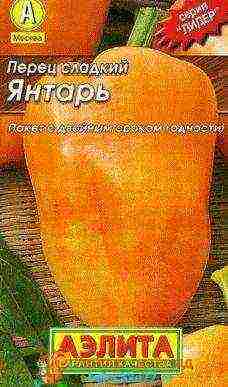
- Agapovsky - an early ripe variety, up to 120 days before the technical maturity of the fruit. Medium-sized plant, compact, many large dark green leaves. The fruits are large (up to 120 grams), smooth, prismatic, bright scarlet. Wall thickness is about 7 mm. Fruits of high quality, good taste and aroma.

- Nikitich -early maturing, before the first fruits 92 days. Plants are low, medium-branched, standard. Fruits are large (on average 120 grams, but they grow larger), drooping, color - dark red, wall thickness about 8 mm. Very good taste.
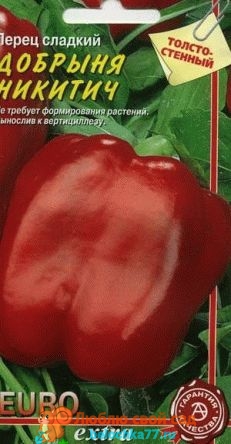
- Gingerbread man - early maturing. Low, standard plant - only up to 30 cm, with dense foliage. Fruits are round (about 8 in diameter, 5.5 cm high), weighing up to 160 grams, very tasty. Thick-walled - about 8 mm., Dark red. The fruits ripen together. For growing in greenhouses.
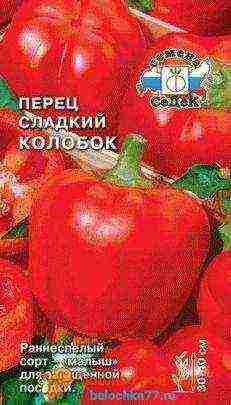
- Knight - early ripening variety. Grown in open ground and in tunnels. The plant is medium up to 50 cm tall, semi-spreading. Large fruits, dark red, conical, drooping. The average weight of fruits is up to 130 grams, but can be larger, thick-walled - about 8 mm. High yielding variety, excellent taste.
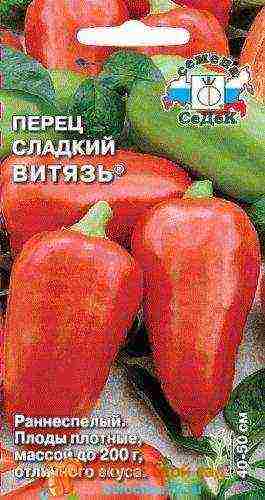
Mid-season peppers for the Urals
- Atlant - mid-season variety for cultivation in tunnels and open field. Sprawling tall plant. The fruit is in the form of a drooping cone, red in biological ripeness. Large-fruited, weighing up to 200 grams, wall thickness about 5 mm, excellent sweet taste. The variety is fruitful and tolerates any weather conditions.

- Bogatyr - mid-season variety. It tolerates unfavorable weather, temperature fluctuations and lack of lighting. Conical, very large fruits (weighing about 180 grams, up to 18 cm long!). Very good taste - juicy, sweet. Good fresh and prepared. The plant is sprawling, powerful, medium-sized, up to 70 cm in height. For cultivation in greenhouses, tunnels and open field. Yielding, suitable for sale, since the fruits tolerate transportation well and are aligned in size.
- Alesha Popovich - mid-season. For open ground, tunnels and film shelters. Tall plant, openwork, low-leaved. Fruits are red (weighing up to 170 g), drooping, smooth, prismatic. Wall thickness up to 8mm, good taste, but weak aroma. Does not require pinching and plant formation. The variety is fruitful, the fruit sets when the temperature fluctuates.
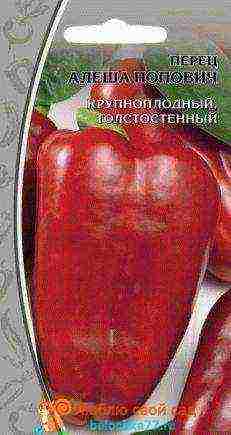
- Player - mid-season variety (up to the first fruits up to 120 days). Suitable for greenhouses, greenhouses and open ground. Plants grow up to 60 cm. Almost cuboid fruits, large (about 150 grams), rich red color.Very thick-walled - up to 12 mm. A very tasty variety, high-yielding with a friendly return of the fruit. Unpretentious in cultivation.
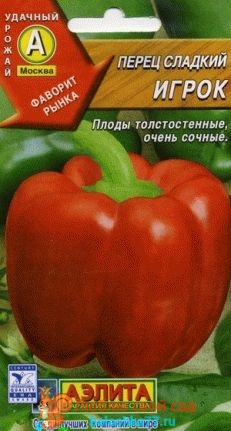
Of course, there are many more varieties that are still suitable for cultivation in the Urals and in general in the area of risky farming. If you are interested in the description of some other varieties, then write in the comments.
I suggest reading other articles:
- Pepper seedlings. 7 major mistakes
- Tomato varieties for the Urals
- Pumpkin varieties with photos and descriptions
- Types of cabbage with photos and descriptions
- Kale cabbage - useful properties, cultivation
Best regards, Sophia Guseva.
If you liked the article, share it with your friends on social networks.


